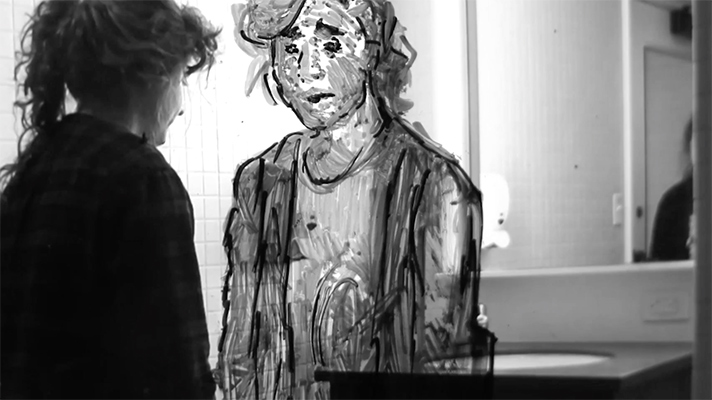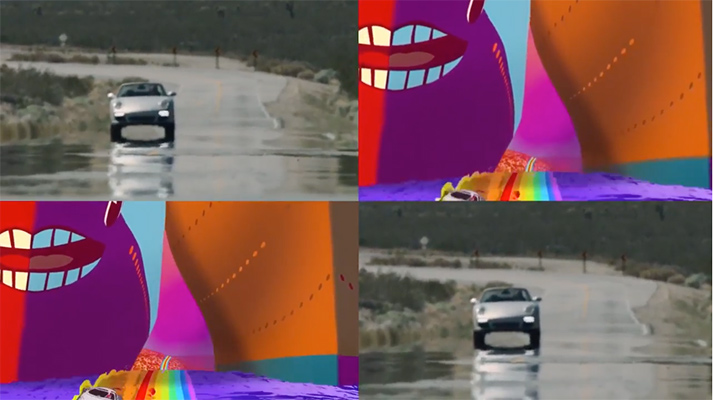Any gallery space presents some limitations—the physical dimensions of a room, for instance, dictate what can be shown inside. But those same spaces can offer unique possibilities for creativity and experimentation as well.
Megan Bailey, a Ph.D. candidate in public policy at the Harvard Kennedy School, explored that idea in her digital installation The Binding Constraint, recently on view in the Harvard Art Museums’ Lightbox Gallery. Because of the gallery’s compact size and its glass walls and roof, she said, “viewing video there can be challenging. That got me thinking more generally about constraints in life. By their very nature, constraints are frustrating, but we can also lean into them and realize that constraints can guide and shape who we are.” As the first step in creating her installation, Bailey used her own website to invite people to submit stories focused on the idea of how the things that constrain us sometimes make us stronger. Her installation is a blend of video, text, and audio recordings that draw from those submissions.
Bailey’s project is one of a dozen created by students in the course Animation/Studio, in Harvard’s Department of Visual and Environmental Studies (VES). Taught by Matt Saunders, an assistant professor in the department and an artist himself, the class considered animation in broad terms, even how still images can be a form of animation. Most weeks, a portion of the class took place in the Lightbox Gallery, a space meant to encourage digital experimentation and imaginative approaches to collections data.
As their final assignment, students were tasked with producing individual installations for the Lightbox Gallery. The projects would be displayed one week at a time, from late 2016 through the spring semester. (Click here for a full list of projects and dates.)
“The idea that the students had a chance to see their work in the museums, even for a limited time, was really exciting to me,” said Saunders.
Students in the course were just as enthusiastic. Bailey found the class “a great opportunity to have a piece in a public place and to have an impact on people.”
Faye Zhang, a senior with a concentration in English and a secondary in visual and environmental studies, said she found the experience helpful as she considers a possible career in filmmaking. “I learned a lot about curation and how to present art,” she said.
Zhang’s project explores the sensation of resistance—the screens depict birds trying to take flight, for instance. She also will install sculptures in the gallery and place two-dimensional artworks on the windows. The work, titled Bird Thud, is scheduled for the week of March 27.
“I’d never done animation combined with installation,” Zhang said. “I wanted to treat each surface as something I could play with and to treat the Lightbox Gallery as an environment rather than just using the screen.”
The work has a political undertone, which evolved as the semester progressed. “I was thinking of the glass ceiling analogy and what you would have to do to break out of it,” she said.
Other students dealt with the art-making process, the blurry line between reality and fiction, viral videos, and emojis, among other topics. They worked with hand-drawn animation, computer graphics, photography, and film.
Brooke Bourgeois’s Dancing With/By Myself investigates self-perception and how we distort images. In the work, which was shown on the gallery’s nine-panel screen, Bourgeois manipulates an image of herself using a hand-drawn animation. Hillary Do’s Untitled, on the other hand, did not make use of the screen but instead incorporated three physical partitions with hanging screens, upon which three dots of various sizes were projected. The piece “seeks to conceptually confront the space . . . through distance, perspective, and movement,” according to her project description.
Creating and mounting a public project is often intense and complicated, involving close collaboration with the museums staff who manage the gallery space. “We learned a lot from the experience of hosting the class and the students’ final projects,” said Chris Molinski, the Rabb Curatorial Fellow in the Division of Academic and Public Programs.
“Each of these projects helps us flex the possibilities of what we can do in the Lightbox,” Molinski said. “The class is a kind of prototype for future collaboration, modeling new ways to partner with faculty and students on creative experiments.”





